Key takeaways
- Student agency enhances motivation and engagement by giving learners a voice and choice in their education.
- Activist teachers foster student autonomy by challenging traditional norms and advocating for meaningful involvement in the learning process.
- Implementing structured choice and collaborative decision-making shifts the classroom dynamic, promoting accountability and respect among students.
- Practical tools like reflection journals and curated resource kits help deepen students’ understanding of their choices and empower their learning journey.

Understanding Student Agency
Student agency is more than just a buzzword; it’s about empowering learners to take the lead in their own education. From my experience, when students feel they have a voice and choice in what they learn, their motivation and engagement skyrocket. Have you ever noticed how different a classroom feels when students are genuinely invested?
I remember one particular class where I shifted the control over project topics to the students. The transformation was remarkable. Instead of passively following instructions, they became curious explorers, driven by their own interests and questions. This sense of ownership gave me new insights into how deeply students can connect with learning when agency is truly in their hands.
But what does student agency really mean day-to-day? For me, it’s about creating opportunities for students to make decisions, solve problems, and reflect on their learning. It calls on teachers to trust students’ judgment and to support their growth as independent thinkers. Isn’t education more meaningful when it’s personally relevant and self-directed?
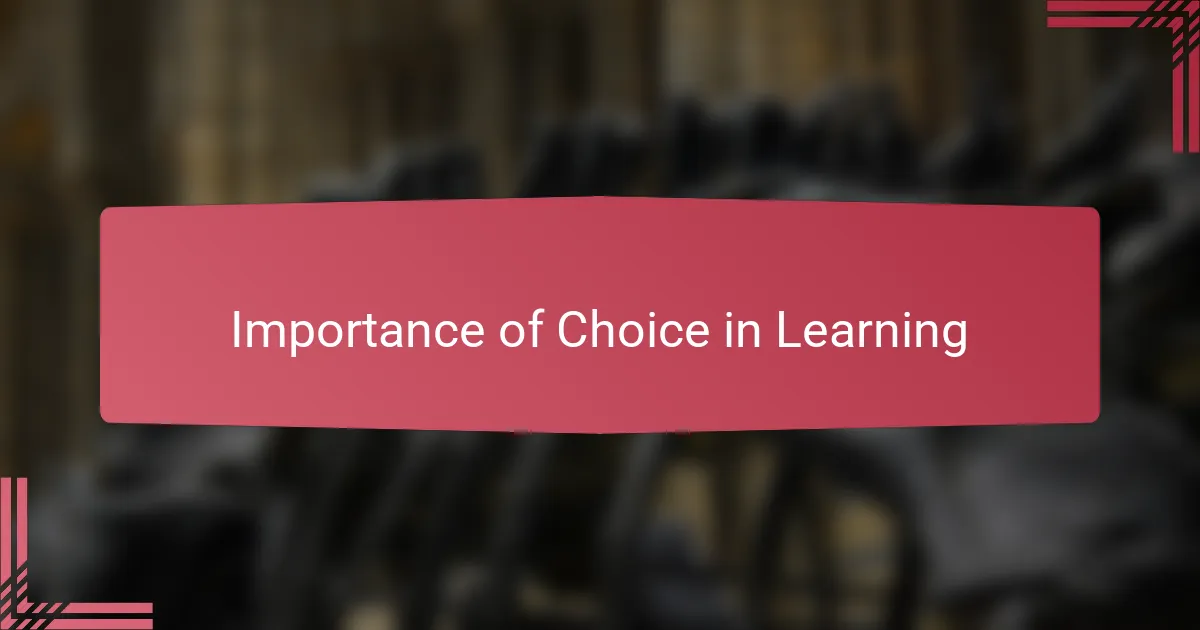
Importance of Choice in Learning
Choice in learning isn’t just a nice-to-have; it’s a crucial element that fuels students’ passion and commitment. I’ve witnessed firsthand how even small choices—like selecting a book or deciding how to present a project—can spark a sense of responsibility and pride. Doesn’t it make sense that when learners feel in control, they naturally put more heart into their work?
I recall a moment when a student chose to explore a subject completely outside the standard curriculum. The enthusiasm they showed was contagious, elevating the whole class’s energy. This experience taught me that giving students meaningful options validates their interests and encourages deeper engagement—something no standard assignment can replicate.
Sometimes, I wonder why we don’t prioritize choice more in education. Is it fear of losing control, or simply habit? From what I see, fostering choice doesn’t weaken structure; instead, it builds a foundation where students can thrive as confident decision-makers. After all, isn’t learning about discovering what truly matters to each learner?
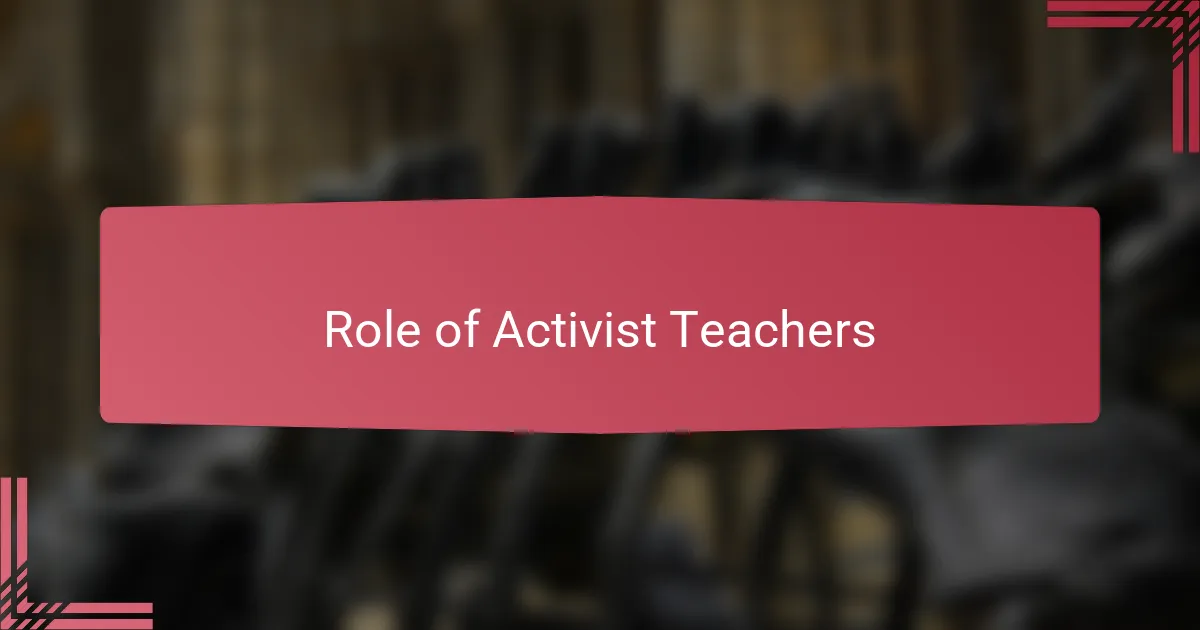
Role of Activist Teachers
Activist teachers play a vital role in championing student agency by challenging traditional norms that limit learner autonomy. From my experience, taking this stance isn’t always easy—it means risking established routines and sometimes facing skepticism. Yet, I’ve found that pushing for choice in the classroom creates a ripple effect, transforming not only students but also the entire learning community.
I remember early in my career feeling hesitant about relinquishing control, worried that students might flounder without tight guidance. But as I witnessed them take ownership and surprise me with their creativity and insight, I realized that being an activist teacher means trusting students’ capabilities while advocating for their rights to meaningful involvement. Isn’t that the essence of teaching: supporting growth beyond content delivery?
Being an activist teacher is ultimately about commitment—committing to equity, student voice, and transformative education. It’s about showing up daily ready to listen, to adapt, and to fight for learning environments where all students can flourish as active agents of their own education. Have you ever experienced the profound impact that this dedication can have on your classroom culture?
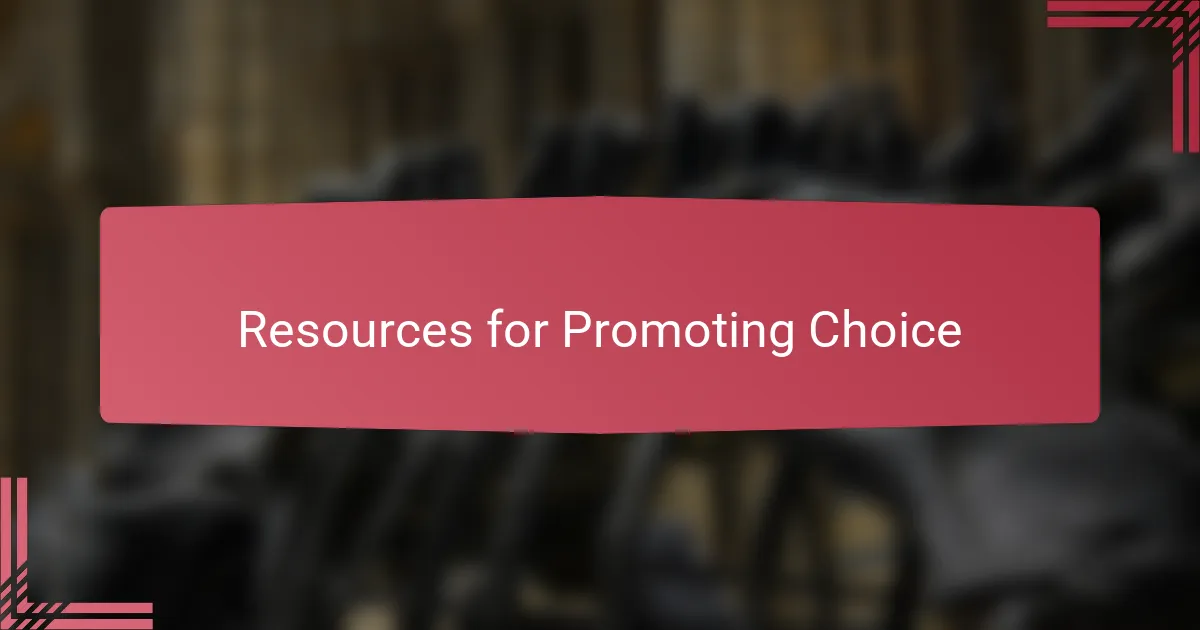
Resources for Promoting Choice
When I first started incorporating curated resource kits aimed specifically at promoting student choice, I noticed a distinct shift in how students approached their work. These materials—ranging from interactive digital tools to customizable project frameworks—offer practical ways to hand over the reins without feeling like you’re losing control. Have you tried using choice boards or menus that let students pick activities aligned with their interests? From my experience, these tools act like scaffolds, supporting student independence without abandoning them.
I also rely heavily on open-source lesson plans and collaborative platforms where educators share strategies that prioritize choice. One particular shared resource introduced me to tiered assignments that empower students to select tasks matching their readiness, fostering both challenge and confidence. This approach not only respects diverse learning styles but also cultivates intrinsic motivation—something I believe every teacher aims to achieve.
Then there’s the power of student reflection journals and feedback apps that help learners articulate why they make certain choices. I’ve seen firsthand how these tools deepen self-awareness and reinforce agency by making students active participants in assessing their growth. Isn’t this kind of ongoing dialogue between teacher and student what genuine empowerment looks like? For me, integrating such resources transforms choice from a theoretical ideal into a living, breathing classroom reality.
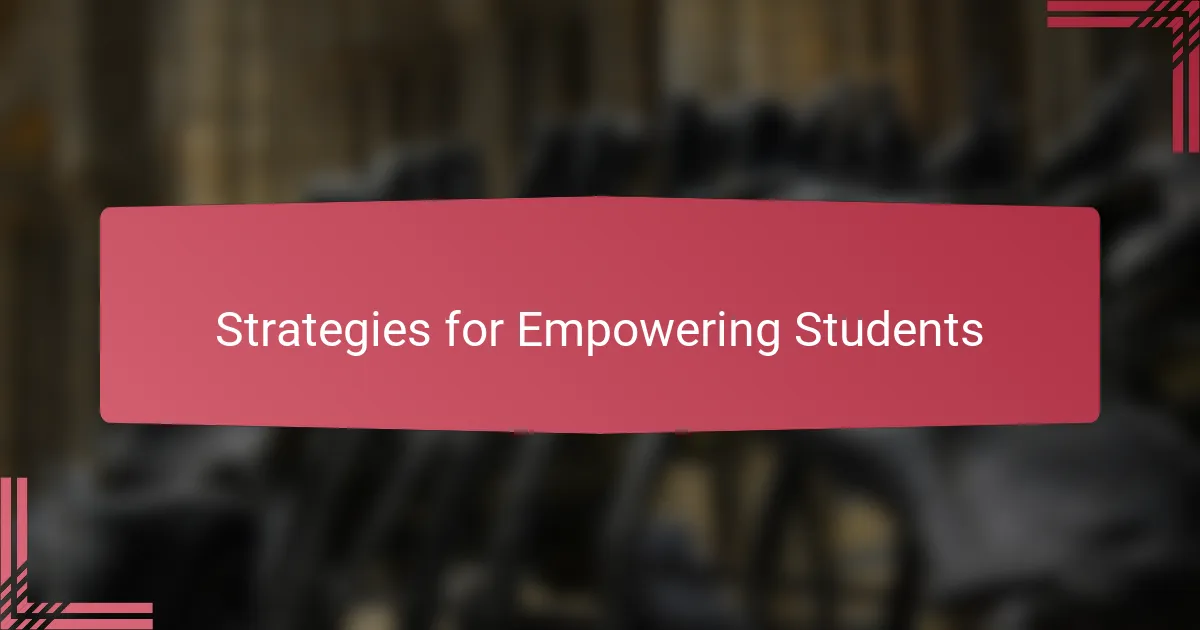
Strategies for Empowering Students
One strategy I’ve found effective is offering structured choice within clear boundaries. For example, giving students a selection of topics or formats to explore helps them feel in control without overwhelming them. Have you noticed how students become more invested when they can tailor tasks to their strengths while still meeting learning goals? It strikes me that this balance nurtures both independence and confidence.
Another approach involves fostering collaborative decision-making. Inviting students to co-create class norms or project criteria shifts the classroom dynamic from teacher-led to student-centered. I’ve seen how this shared ownership encourages accountability and mutual respect—elements often missing in traditional setups. Isn’t it powerful when students realize their voices genuinely shape their learning environment?
Reflection routines also play a vital role. I encourage students to regularly assess their choices and outcomes, which deepens their understanding of agency. One time, a student’s thoughtful journal entry revealed how selecting a preferred reading changed not only their engagement but also their perception of learning itself. Doesn’t that kind of insight remind us why empowering students is so worth the effort?
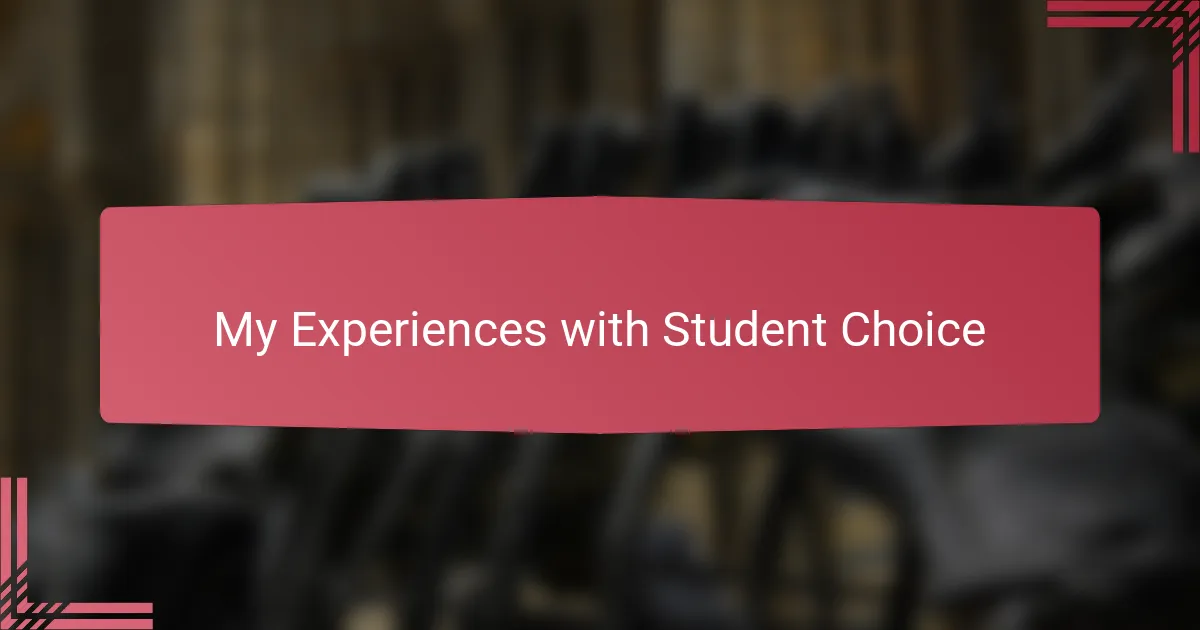
My Experiences with Student Choice
Over the years, I’ve watched students light up when given the chance to choose their own path. One memorable example was a creative writing assignment where I let students pick their genres. The variety of stories—from sci-fi to heartfelt memoirs—not only showcased their unique voices but also deepened their connection to the task. Have you noticed how choice can unlock a student’s hidden passions?
Sometimes, handing over choice feels risky—what if students pick something too easy or off-topic? Yet, my experience tells me that with a bit of guidance, they often surprise you. I remember a student who selected a challenging science project, initially unsure but fully committed, eventually presenting with such confidence that it inspired peers to stretch themselves. Doesn’t that moment underscore the power of trust in promoting agency?
There are also quieter, everyday moments when student choice reveals its impact. Like when a student opted to lead a group discussion rather than take notes; this small decision boosted their leadership skills and made the group more engaged overall. Isn’t it fascinating how even tiny choices can ripple out and transform the classroom dynamic?
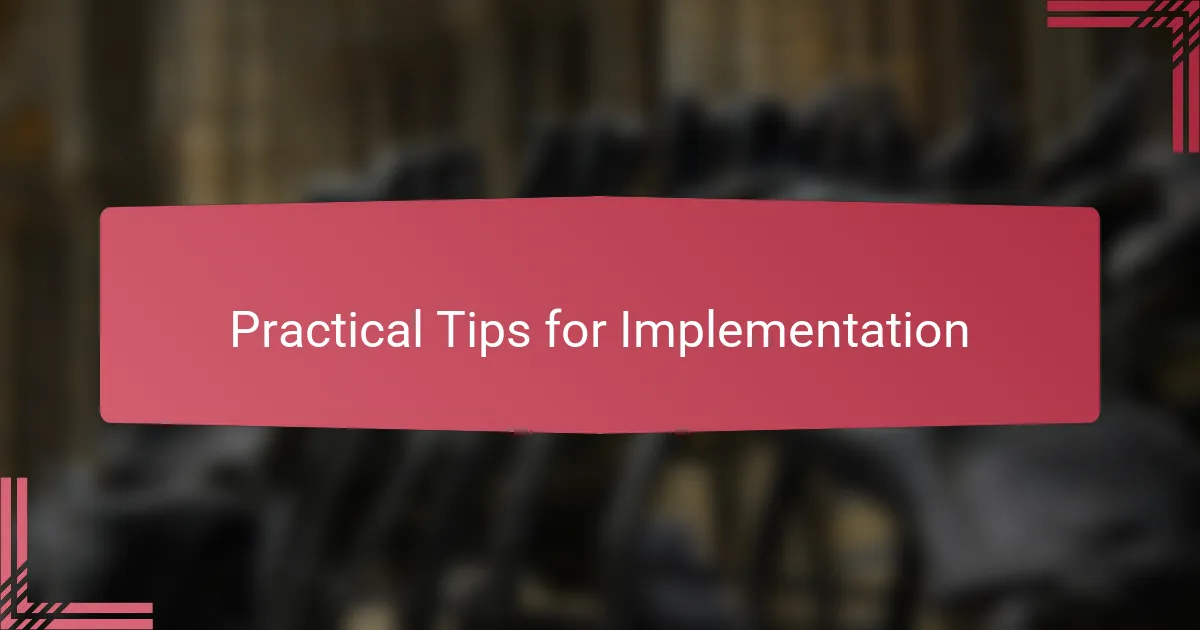
Practical Tips for Implementation
One practical tip I often lean on is starting small with choice—offering students just two or three options rather than an overwhelming menu. In my experience, this keeps the decision manageable and prevents choice fatigue. Have you ever noticed how even a simple “pick your own topic” option can shift a student’s mindset from compliance to curiosity?
Another strategy is to build routines that encourage reflection on those choices. I’ve found that when students regularly consider why they picked a certain project or method, they develop deeper self-awareness and a stronger sense of ownership. Isn’t it amazing how pausing to think can turn a simple task into a meaningful learning moment?
Lastly, collaboration can’t be underestimated. When students help shape the criteria or negotiate deadlines, I’ve seen their commitment to the work grow exponentially. It’s as if inviting them into the decision-making circle signals, “You belong here, and your input truly matters.” What could be more empowering than that?